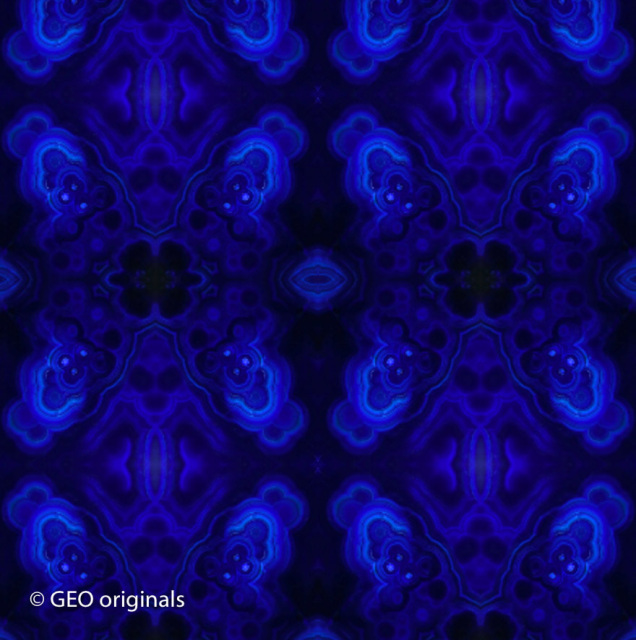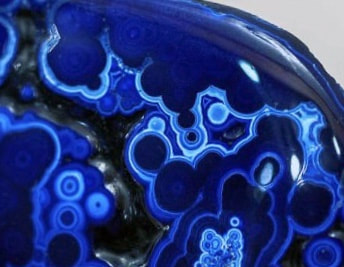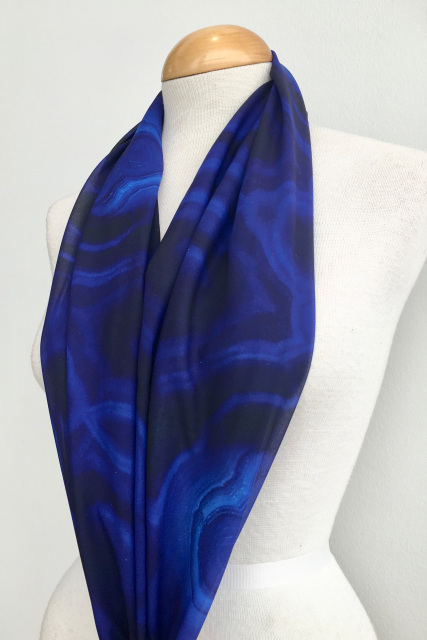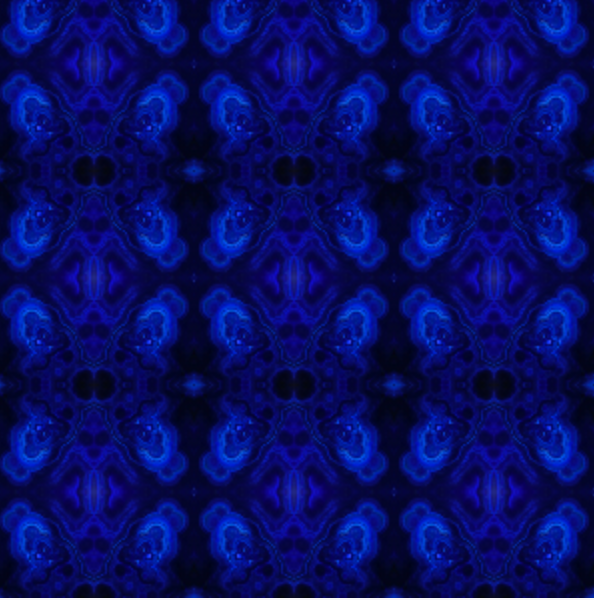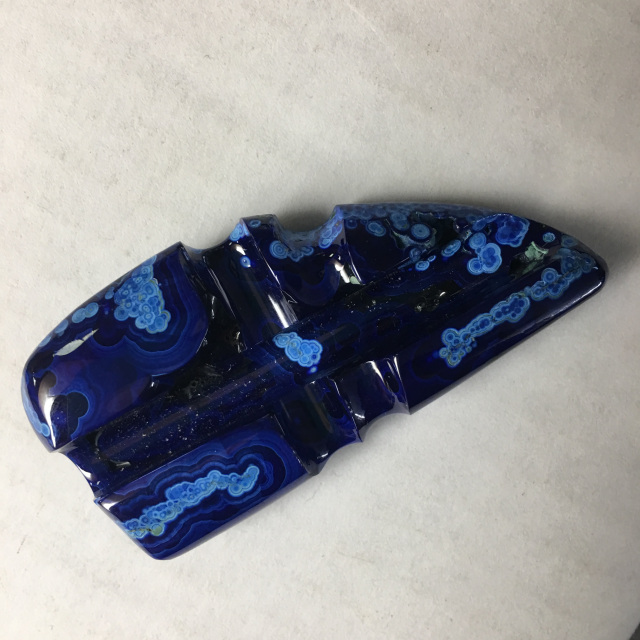- Fabric (by the yard)
- >
- Bisbee Azurite (Arizona) GEO 6006
Bisbee Azurite (Arizona) GEO 6006
SKU:
$92.00
89
92
$89.00 - $92.00
Unavailable
per item
Fabric by the Yard
Bisbee Azurite
(Bisbee, Arizona)
GEO 3326
Azurite
from Bisbee, Arizona
The great azurite specimens produced at Bisbee are probably the most sought after azurites by American collectors.
The Copper Queen Mine near Bisbee was a prolific producer until its closure in 1888. It was said the in the older workings of the mine this mineral was abundant, occurring in large and beautiful masses with azurite and calcite in limestone caverns. The walls of these caves were covered with velvety moss-green malachite, and sparkled with the blue crystals of azurite, while from the roofs hung translucent stalactite draperies of calcite, delicately banded and tinted with the salts of copper.
Azurite is a secondary mineral that usually forms when carbon-dioxide-laden waters descend into the Earth and react with subsurface copper ores. The carbonic acid of these waters dissolves small amounts of copper from the ore. The dissolved copper is transported with the water until it reaches a new geochemical environment. This new environment could be a location where water chemistry or temperature changes, or where evaporation occurs. If conditions are right, the mineral azurite might form.
Azurite was ground and used as a pigment in blue paint as early as ancient Egypt. Through time, its use became much more common. During the Middle Ages and Renaissance, it was the most important blue pigment used in Europe. Much of the azurite used to make the pigment was mined in France.
The Copper Queen Mine was first discovered in 1877, and ever since, the history of this mine rivals the drama of an old western. Silver and copper deposits were reported in the early 1870s, and in 1877 , rich outcrops were found for prospectors to dig into.
To set the stage, the Copper Queen Mine is situated, in what was then, hostile Apache territory in Arizona, and the U.S. Calvary patrolled the area. One day, they were searching for water in a canyon in the Mule Mountains of Southeastern Arizona, when they noticed outcrops that were tinted red with iron. These outcrops were said to contain cerussite, a lead mineral that was often found with silver; a good sign for prospectors. Sgt. George Dunn grubstaked (outfitted with provisions in exchange for part ownership) the area to George Warren to start the mining operation with a handmade map of the area. Warren proceeded to get drunk in the Bruneko Saloon, told everyone within earshot about the discovery, using his name for the area, and then proceeded to lose his stake in the operation in a horse race. Warren was soon declared insane by his partner, and promptly committed to a state asylum in Phoenix in 1881. Shortly thereafter, his partner squandered his small fortune. When a group of miners heard about Warren’s plight, they managed to buy his freedom with a sack of sugar, and Warren emerged from Phoenix penniless. Even so, he almost immediately found himself jailed after wandering into Mexico. He finally returned to Bisbee in time for Christmas in 1892, but unfortunately caught pneumonia and died. Warren’s strange life came to a quick end, but he was responsible for getting the word out about the ores that people were looking for, and when the did, they named the mining district in his honor.
The tale of the Copper Queen picks up in 1880 when Benjamin and Lewis Williams and Judge De Witt Bisbee leased and bought multiple mining claims, including the Copper Queen. Bisbee was crucial to the area’s survival; he invested large amounts of capital to build a smelter in the town to save money instead of shipping ore to Wales, Arizona. The town was named after him in 1880 when it transformed from a collection of tents and hastily constructed buildings to a real mining town. The Copper Queen Mining Company was formed, and the rich ores they discovered rewarded the investors. The discovery site was quarried until a massive pit formed, and a shaft and tunnels were then constructed to follow rich copper veins. By the time all was said and done, the mine had hundreds of kilometers of tunnels and stopes that were developed until nearly all of Bisbee mine became connected underground. Despite of considerable exploration, in mid-1884 it seemed only a few months of ore remained in the Copper Queen mine. The Phelps Dodge & Company had opened the Atlanta mine adjacent to the Copper Queen in hopes of encountering similar geology, but the initial results were not as good. In one of the last mining efforts in the Copper Queen hit an ore body 60 meters in the main shaft. The same ore body was just discovered in the adjacent Atlanta mine at the same time. The Copper Queen Consolidated Mining Company formed from the two companies to give the mine a second chance. They held control over the area of Bisbee for 15 years until Phelps Dodge developed adjacent areas Copper Queen Consolidated had overlooked, and eventually took over the Copper Queen.
One of the mineral forms of metallic copper is azurite. It is a carbonate mineral of copper with the chemical composition Cu3(CO3)2(OH)2.
This is what we do...
With environmental consciousness in mind, our fabrics are all printed using completely water-based inks. This means no chemicals or solvents are used. We transfer those images onto luxurious fabric using ecologically safe transfer sublimation inks that provide vibrant color. The printing process uses no water and uses non-toxic bio-degradable inks. Our heat fixing procedure fixes the colors and prints, avoiding the downsides of steaming, such as excess or contaminated water returning into the waste system. The textile industry is rife with sustainability problems: from the use of toxic inks and wasteful practices for materials and water, to a race to utilize the cheapest materials such as vinyl—no matter the environmental impact. Our print-on-demand process is designed to minimize fabric and ink waste. Reducing the use of materials, energy and water by choosing a pigment printing process instead of reactive dye.
Making use of stone that we personally collect, cut and polish to a mirror finish, coupled with high powered lenses, we transport the viewer into a microscopic world, far beyond what the naked eye perceives. The diversity, originality and beauty of what is revealed defy description. Those images are then transferred onto a variety of mediums. Consider textiles that are transformed into decor including decorative pillows, bedding, table linens, for both home and commercial use. And fabrics for the fashion world. GEO originals has opened the door to a realm of beauty crossing all genres with endless applications.
Choose your favorite(s) images, choose your fabric and let us know how many yards! We will also provide additional custom order fabrics upon request (please contact GEO originals).
This image is for illustrative purposes only.
The colors shown are accurate within the constraints of lighting, photography and the color accuracy of your screen.
All of our macro photographs are of our own stone; cut and polished, exposing the natural beauty inside.
(All photos shown are watermarked for online viewing. The purchased art will not show watermark.)
©Light the Earth, All Rights Reserved
Copyrighted. No Usage Without Permission
from Bisbee, Arizona
The great azurite specimens produced at Bisbee are probably the most sought after azurites by American collectors.
The Copper Queen Mine near Bisbee was a prolific producer until its closure in 1888. It was said the in the older workings of the mine this mineral was abundant, occurring in large and beautiful masses with azurite and calcite in limestone caverns. The walls of these caves were covered with velvety moss-green malachite, and sparkled with the blue crystals of azurite, while from the roofs hung translucent stalactite draperies of calcite, delicately banded and tinted with the salts of copper.
Azurite is a secondary mineral that usually forms when carbon-dioxide-laden waters descend into the Earth and react with subsurface copper ores. The carbonic acid of these waters dissolves small amounts of copper from the ore. The dissolved copper is transported with the water until it reaches a new geochemical environment. This new environment could be a location where water chemistry or temperature changes, or where evaporation occurs. If conditions are right, the mineral azurite might form.
Azurite was ground and used as a pigment in blue paint as early as ancient Egypt. Through time, its use became much more common. During the Middle Ages and Renaissance, it was the most important blue pigment used in Europe. Much of the azurite used to make the pigment was mined in France.
The Copper Queen Mine was first discovered in 1877, and ever since, the history of this mine rivals the drama of an old western. Silver and copper deposits were reported in the early 1870s, and in 1877 , rich outcrops were found for prospectors to dig into.
To set the stage, the Copper Queen Mine is situated, in what was then, hostile Apache territory in Arizona, and the U.S. Calvary patrolled the area. One day, they were searching for water in a canyon in the Mule Mountains of Southeastern Arizona, when they noticed outcrops that were tinted red with iron. These outcrops were said to contain cerussite, a lead mineral that was often found with silver; a good sign for prospectors. Sgt. George Dunn grubstaked (outfitted with provisions in exchange for part ownership) the area to George Warren to start the mining operation with a handmade map of the area. Warren proceeded to get drunk in the Bruneko Saloon, told everyone within earshot about the discovery, using his name for the area, and then proceeded to lose his stake in the operation in a horse race. Warren was soon declared insane by his partner, and promptly committed to a state asylum in Phoenix in 1881. Shortly thereafter, his partner squandered his small fortune. When a group of miners heard about Warren’s plight, they managed to buy his freedom with a sack of sugar, and Warren emerged from Phoenix penniless. Even so, he almost immediately found himself jailed after wandering into Mexico. He finally returned to Bisbee in time for Christmas in 1892, but unfortunately caught pneumonia and died. Warren’s strange life came to a quick end, but he was responsible for getting the word out about the ores that people were looking for, and when the did, they named the mining district in his honor.
The tale of the Copper Queen picks up in 1880 when Benjamin and Lewis Williams and Judge De Witt Bisbee leased and bought multiple mining claims, including the Copper Queen. Bisbee was crucial to the area’s survival; he invested large amounts of capital to build a smelter in the town to save money instead of shipping ore to Wales, Arizona. The town was named after him in 1880 when it transformed from a collection of tents and hastily constructed buildings to a real mining town. The Copper Queen Mining Company was formed, and the rich ores they discovered rewarded the investors. The discovery site was quarried until a massive pit formed, and a shaft and tunnels were then constructed to follow rich copper veins. By the time all was said and done, the mine had hundreds of kilometers of tunnels and stopes that were developed until nearly all of Bisbee mine became connected underground. Despite of considerable exploration, in mid-1884 it seemed only a few months of ore remained in the Copper Queen mine. The Phelps Dodge & Company had opened the Atlanta mine adjacent to the Copper Queen in hopes of encountering similar geology, but the initial results were not as good. In one of the last mining efforts in the Copper Queen hit an ore body 60 meters in the main shaft. The same ore body was just discovered in the adjacent Atlanta mine at the same time. The Copper Queen Consolidated Mining Company formed from the two companies to give the mine a second chance. They held control over the area of Bisbee for 15 years until Phelps Dodge developed adjacent areas Copper Queen Consolidated had overlooked, and eventually took over the Copper Queen.
One of the mineral forms of metallic copper is azurite. It is a carbonate mineral of copper with the chemical composition Cu3(CO3)2(OH)2.
This is what we do...
With environmental consciousness in mind, our fabrics are all printed using completely water-based inks. This means no chemicals or solvents are used. We transfer those images onto luxurious fabric using ecologically safe transfer sublimation inks that provide vibrant color. The printing process uses no water and uses non-toxic bio-degradable inks. Our heat fixing procedure fixes the colors and prints, avoiding the downsides of steaming, such as excess or contaminated water returning into the waste system. The textile industry is rife with sustainability problems: from the use of toxic inks and wasteful practices for materials and water, to a race to utilize the cheapest materials such as vinyl—no matter the environmental impact. Our print-on-demand process is designed to minimize fabric and ink waste. Reducing the use of materials, energy and water by choosing a pigment printing process instead of reactive dye.
Making use of stone that we personally collect, cut and polish to a mirror finish, coupled with high powered lenses, we transport the viewer into a microscopic world, far beyond what the naked eye perceives. The diversity, originality and beauty of what is revealed defy description. Those images are then transferred onto a variety of mediums. Consider textiles that are transformed into decor including decorative pillows, bedding, table linens, for both home and commercial use. And fabrics for the fashion world. GEO originals has opened the door to a realm of beauty crossing all genres with endless applications.
Choose your favorite(s) images, choose your fabric and let us know how many yards! We will also provide additional custom order fabrics upon request (please contact GEO originals).
This image is for illustrative purposes only.
The colors shown are accurate within the constraints of lighting, photography and the color accuracy of your screen.
All of our macro photographs are of our own stone; cut and polished, exposing the natural beauty inside.
(All photos shown are watermarked for online viewing. The purchased art will not show watermark.)
©Light the Earth, All Rights Reserved
Copyrighted. No Usage Without Permission
